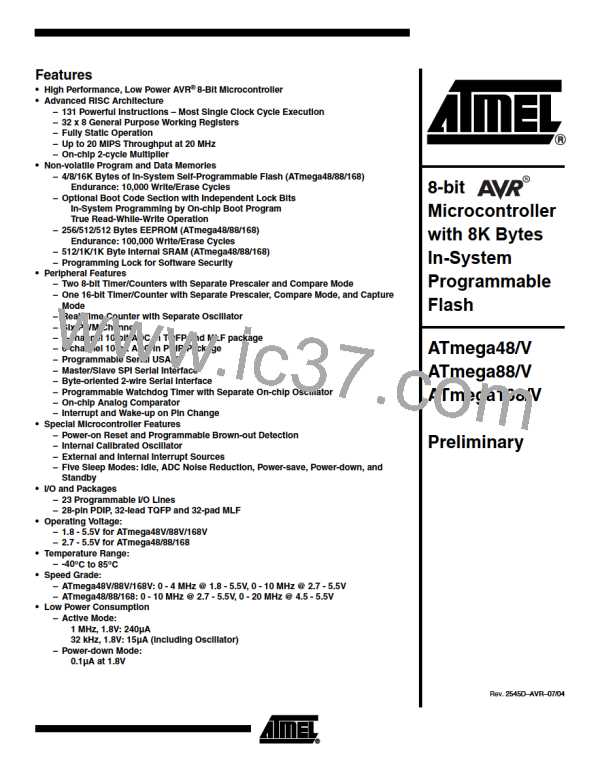extended I/O. Typically “LDS” and “STS” combined with “SBRS”, “SBRC”, “SBR”, and
“CBR”.
More advanced initialization routines can be made that include frame format as parame-
ters, disable interrupts and so on. However, many applications use a fixed setting of the
baud and control registers, and for these types of applications the initialization code can
be placed directly in the main routine, or be combined with initialization code for other
I/O modules.
Data Transmission – The The USART Transmitter is enabled by setting the Transmit Enable (TXEN) bit in the
UCSRnB Register. When the Transmitter is enabled, the normal port operation of the
USART Transmitter
TxDn pin is overridden by the USART and given the function as the Transmitter’s serial
output. The baud rate, mode of operation and frame format must be set up once before
doing any transmissions. If synchronous operation is used, the clock on the XCKn pin
will be overridden and used as transmission clock.
Sending Frames with 5 to 8
Data Bit
A data transmission is initiated by loading the transmit buffer with the data to be trans-
mitted. The CPU can load the transmit buffer by writing to the UDRn I/O location. The
buffered data in the transmit buffer will be moved to the Shift Register when the Shift
Register is ready to send a new frame. The Shift Register is loaded with new data if it is
in idle state (no ongoing transmission) or immediately after the last stop bit of the previ-
ous frame is transmitted. When the Shift Register is loaded with new data, it will transfer
one complete frame at the rate given by the Baud Register, U2Xn bit or by XCKn
depending on mode of operation.
The following code examples show a simple USART transmit function based on polling
of the Data Register Empty (UDREn) Flag. When using frames with less than eight bits,
the most significant bits written to the UDRn are ignored. The USART has to be initial-
ized before the function can be used. For the assembly code, the data to be sent is
assumed to be stored in Register R16
Assembly Code Example(1)
USART_Transmit:
; Wait for empty transmit buffer
sbis UCSRnA,UDREn
rjmp USART_Transmit
; Put data (r16) into buffer, sends the data
out UDRn,r16
ret
C Code Example(1)
void USART_Transmit( unsigned char data )
{
/* Wait for empty transmit buffer */
while ( !( UCSRnA & (1<<UDREn)) )
;
/* Put data into buffer, sends the data */
UDRn = data;
}
Note:
1. The example code assumes that the part specific header file is included.
For I/O Registers located in extended I/O map, “IN”, “OUT”, “SBIS”, “SBIC”, “CBI”,
168
ATmega48/88/168
2545D–AVR–07/04

 ATMEL [ ATMEL ]
ATMEL [ ATMEL ]